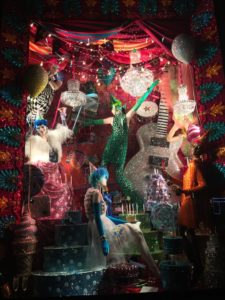
A lot of trial lawyers extol the virtues of storytelling when they talk about developing winning strategies. And while I love a good story as much as the next lawyer, jurors are being sold short if your trial strategy relies too heavily on a well-told story alone.
Want to know what really sells? Take a look at the display windows at Neiman Marcus, as an example. If you’ve ever strolled by the high-end department store, you may have noticed these elaborate and beautiful glass-encased displays. The next time you walk by, take a closer look and you’ll see it’s more than just pretty. Those windows are actually well-thought-out tableaus, meticulously designed by artists with an appreciation for subtlety, an attention to detail and a facility for subliminal storytelling. They know their audience and the subject matter they have to present.
I recently saw one featuring a beautiful designer dress along with a gallery of curated artwork suggesting the theme of the dress and where it would be appropriate to wear (presumably, not in court). Every element of the window worked as part of the whole, telling a complete story.
Conversely, you wouldn’t see a window displaying a Prada purse, a pair of baby slippers, and a Tiffany crystal bowl because those items don’t tell a story at all. While they may be beautiful and interesting, no one knows why they’re together.
Evidence First, Storytelling Second

A well thought-out store window display (such as this one at Bergdorf Goodman) is more than a collection of pretty baubles.
The same is True when constructing a trial strategy: You must know your evidence, backwards, forwards and sideways in order to make sure there is a sound structure for your narrative. Otherwise, it’s just a story, and one the jury might not support.
A successful trial strategy is, first and foremost, about the evidence. Once you know the facts and what evidence the jury will see, only then is it time to tie it all together into a cohesive narrative. Jurors will see through a superficial story – one built more on style than substance – and will act accordingly.
Similarly, jurors don’t want or need to be force fed. Just as a well-written mystery drops breadcrumbs leading attentive readers to the big reveal, jurors also appreciate being allowed to come to their own conclusions. Of course, a good trial lawyer will always guide them there without leaving anything to chance, but jurors should never walk out of the courtroom at the end of the day saying, “Alright, already. We get it. Let’s move on.”
Trial lawyers definitely need to tell a story. But they first must focus on the evidence that supports their narrative and only then begin laying the groundwork for the storytelling part of their job.
The Castañeda Firm represents litigation clients in the energy industry and beyond. From offices in Dallas, the firm provides extensive experience in a variety of complex litigation, including oil and gas disputes, complex commercial cases, products liability suits, and toxic torts and other environmental matters. For more information, visit www.castaneda-firm.com or contact info@castaneda-firm.com.
Click here to subscribe to our firm newsletter.